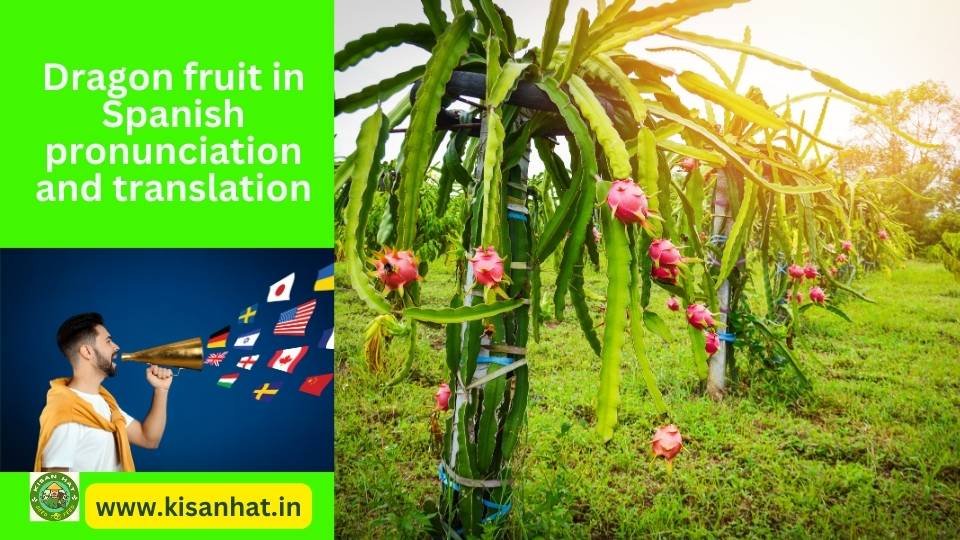Dragon fruit, also known as pitaya, is a tropical fruit that is native to Central America and is widely consumed around the world. It has a vibrant pink or yellow skin with green scales, and its flesh is white or red with tiny black seeds.
Pronunciation of Dragon Fruit in Spanish
In Spanish, dragon fruit is known as “pitaya” or “fruta del dragón.” The pronunciation of pitaya is pee-tah-yah, and the pronunciation of fruta del dragón is froo-tah del drah-gohn. Both pronunciations are widely accepted and used by Spanish speakers.
When pronouncing pitaya, the emphasis is placed on the second syllable, “tah.” The “i” is pronounced as a short “ee” sound, similar to the “i” in the English word “pit.” The “y” is pronounced as a long “ee” sound, similar to the “y” in the English word “sky.”
When pronouncing fruta del dragón, each word is pronounced separately. The emphasis is placed on the first syllable of each word. The “u” in “fruta” is pronounced as a short “oo” sound, similar to the “u” in the English word “put.” The “o” in “dragón” is pronounced as a long “oh” sound, similar to the “o” in the English word “go.”
Translation of Dragon Fruit in Spanish
The translation of dragon fruit in Spanish is “fruta del dragón” or simply “pitaya.” Both translations are commonly used in Spanish-speaking countries.
The translation “fruta del dragón” directly translates to “fruit of the dragon.” This translation refers to the fruit’s unique appearance, which is often associated with mythical creatures like dragons. The word “fruta” means “fruit” in Spanish, and “del dragón” means “of the dragon.”
The translation “pitaya” is the common name used for dragon fruit in many Spanish-speaking countries, especially in Latin America. The origin of the word “pitaya” is believed to come from the indigenous language of the Taino people in the Caribbean. The word “pitaya” does not have a direct English translation.
It’s important to note that the translation and pronunciation of dragon fruit may vary slightly depending on the Spanish-speaking country or region. However, the terms “pitaya” and “fruta del dragón” are widely recognized and understood throughout the Spanish-speaking world.
Health Benefits and Culinary Uses of Dragon Fruit
Dragon fruit is not only delicious but also packed with numerous health benefits. It is low in calories and high in fiber, making it a great choice for those looking to maintain a healthy weight and improve digestion. The fruit is also rich in antioxidants, which help protect the body against oxidative stress and reduce the risk of chronic diseases.
In addition to its health benefits, dragon fruit is versatile in the kitchen. Its sweet and mildly tangy flavor makes it a great addition to smoothies, salads, and desserts. The flesh of the fruit can be scooped out and eaten on its own or used as a topping for yogurt or cereal.
Dragon fruit can also be juiced or blended into refreshing beverages. It can be used to make colorful fruit bowls, where the flesh is scooped out and served in the hollowed-out skin of the fruit. The seeds of the fruit are edible and add a crunchy texture to dishes.
Overall, dragon fruit is not only a visually stunning fruit but also a nutritious and versatile ingredient that can be enjoyed in various ways.
Dragon fruit which country fruit
Conclusion
Dragon fruit, or pitaya, is a tropical fruit that is widely consumed around the world. In Spanish, it is known as “pitaya” or “fruta del dragón.” The pronunciation of pitaya is pee-tah-yah, and the pronunciation of fruta del dragón is froo-tah del drah-gohn.
The translation of dragon fruit in Spanish is “fruta del dragón” or simply “pitaya.” Dragon fruit is not only delicious but also packed with health benefits, and it can be used in various culinary creations. Whether you enjoy it on its own or incorporate it into recipes, dragon fruit is a delightful addition to any diet.



